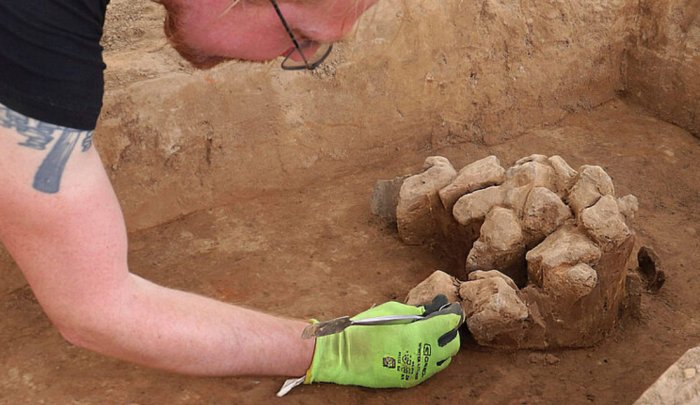Conny Waters – AncientPages.com – For more than a year, archaeologists have been conducting excavations at a multi-hectare site in Holzwickede, which is planned to become part of the Eco Port Süd business park near Dortmund Airport.
Aerial photograph of the excavation site, looking north. The B1 highway and Dortmund Airport are visible at the top. The post-and-beam layouts of the Neolithic houses are visible at the bottom. Photo: LQ Archaeology/C. Bariszlovich
Recent findings indicate that nearly 7,000 years ago, this area was a significant settlement for Stone Age farmers. The archaeological evidence suggests that this area has been a preferred site for habitation for centuries.
In two sections of the extensive excavation site, the team, led by Philipp Bockelbrink, has discovered house plans from an early farming society.
In the northern area, the team has completed a floor plan initially identified during preliminary investigations. In the southern section, they have uncovered remains of at least four buildings and possibly a fifth.
Image credit: LWL-Archäologie for Westphalia/ M.Baales
It is believed that the excavated site may contain two separate areas, both of which date back to approximately 7,000 years ago.
“The houses are characteristic of the Middle Neolithic period, specifically associated with the Rössen culture, which dates back to around 4,700 BC. This type of construction was prevalent in Westphalia, particularly on the fertile loess soils,” explains Prof. Dr. Michael Baales, head of LWL-Archäologie for Westphalia in Olpe.
The Rössen culture, named after a district in Leuna, Saxony-Anhalt, was a Central European culture of the Middle Neolithic period (4,600-4,300 BC). It represented the second major Neolithic cultural group to persist in Central Europe, according to experts in prehistoric archaeology. This culture’s settlements are located in Westphalia, mainly along the Hellweg region, which stretches between Sauerland and south of the Ruhr.
This Iron Age pit was filled with fire debris. Photo: LWL Archaeology for Westphalia. Credits: E. Cichy
Prof. Dr. Michael Baales, head of the LWL-Archäologie for Westphalia in Olpe, explains that the houses excavated at the site are typical of the so-called Middle Neolithic period and can be assigned to the Rössen culture.
Several years ago, several settlements from this time period were discovered in Soest and Dortmund. One house floor plan measuring 65 metres in length and located near Bochum-Gerthe was documented in the 1950s. Its floor plan represents one of the most significant known wooden buildings from prehistoric times.
“The largely complete floor plan made of wooden wrapping with almost 30 metres is almost small. In these houses, at least temporarily, people and animals lived together in a household community, and under the roof, the grain sheltered,” Baales explains.
An unusual collection of stones was found in one of the Iron Age pits, which are carefully exposed here. Photo: LQ Archaeology/C. Bariszlovich
The researchers were only able to see the pits in the ground for the large wooden posts of the slightly curved side walls and other pits for short rows of posts, which also formed the roof and an intermediate floor. However, this is interesting, as many larger pits are to be expected at such sites, which are filled with a wealth of found material.
“However, we hardly have any finds such as ceramic shards, which we can assign to this first settlement phase on the excavation area,” says excavation manager Bockelbrink.
Was the settlement promptly abandoned once more?
In the southern region, an extensive and detailed floor plan intriguingly intersects with what appear to be the remnants of a much earlier structure. This fascinating overlap suggests a complex history potentially filled with layers of cultural or architectural significance.
Currently, this puzzling situation remains an enigma and archaeologists will further explore the site.
Written by Conny Waters – AncientPages.com Staff Writer





